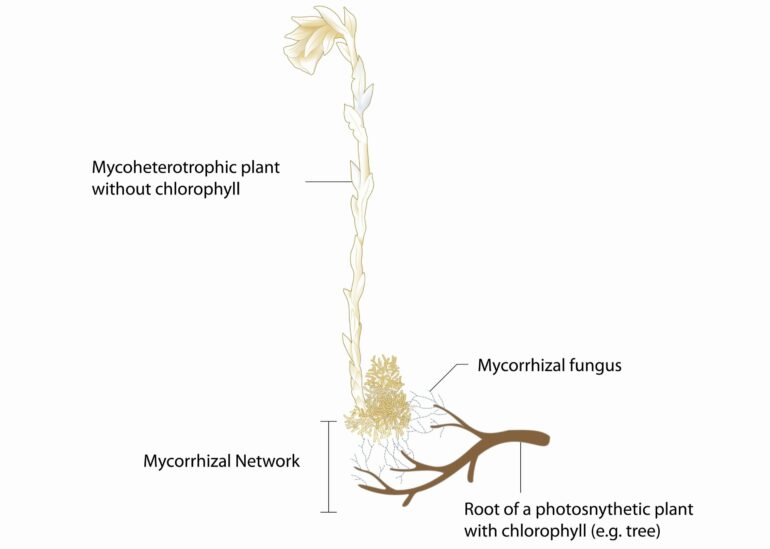Bayreuth researchers shed light on the natural evidence for the occurrence and function of networks of fungi and plants—so-called mycorrhizal networks. Through this “Wood Wide Web,” plants can exchange resources and even information with each other. The researchers have now reported their findings in the journal Nature Plants.
More than 90% of all land plants live in a close symbiosis with fungi, the mycorrhiza. For a long time, mycorrhiza was regarded as an interaction between two partners—a plant and a fungus. However, there are indications that forests in particular may be permeated by entire networks of plant roots and fungal tissue, which enable an exchange of resources and even information between different plants, mediated by common fungal partners.
These indications have sometimes led to fanciful speculation, especially in the popular media, often without a sound scientific background. In response to this, leading scientists have critically questioned the actual significance of these networks in recent publications.
In order to dispel doubts about the importance of mycorrhizal networks, researchers from Bayreuth have scoured the research literature and focused on the previously neglected evidence for the occurrence and function of the “Wood Wide Web.” With this knowledge, many rare and endangered plant species in the forest understory can be better protected in the future through adapted forest management.
The recent review by an international consortium including Prof. Dr. Gerhard Gebauer and his research associate Franziska Zahn from the University of Bayreuth took a closer look at mycoheterotrophic plants and their role in underground networks. In contrast to autotrophic plants, mycoheterotrophic plants do not ensure their carbon supply via photosynthesis, but via a fungal partner.
The vast majority of land plants use symbiosis with mycorrhizal fungi in their roots: The plant receives limited nutrients from the soil via the fungus; in return, the fungus receives carbon from the plant’s photosynthesis. If a mycorrhizal fungus lives in symbiosis with several plants, an underground network, also known as the “Wood Wide Web,” is created.
The widespread occurrence and significance of this network is controversially discussed in the scientific community. “However, one important group of plants that provides obvious evidence for the existence of mycorrhizal networks has been largely overlooked—the mycoheterotrophic plants,” says Gebauer.
Completely mycoheterotrophic plants are usually small and are quickly overlooked in the forest understory. However, they provide the decisive evidence for the importance of the “Wood Wide Web.” They have no green leaves and therefore cannot photosynthesize, which is why they feed entirely at the expense of mycorrhizal fungi. These fungal partners simultaneously enter into a second partnership with forest trees and can mediate carbon exchange between the plants.
“The fully mycoheterotrophic plants thus prove the existence of mycorrhizal networks in which at least three partners—two plants and a fungus—are involved,” says Gebauer.
Thus, mycorrhizal networks in forests can support carbon transfer between plants, challenging the above-mentioned dogma of carbon-for-nutrient exchange in the symbiosis between fungi and plants. Likewise, the assumption that all green plants feed strictly through carbon gain via photosynthesis must be questioned.
The researchers describe the range of possibilities for carbon transfer: at one end of the spectrum are the completely mycoheterotrophic plants that obtain carbon exclusively from their fungal partner. At the other end are those plants that obtain carbon exclusively from photosynthesis. In between, some plants feed to varying degrees at the expense of the fungal partner and from photosynthesis.
More information:
Vincent S. F. T. Merckx et al, Mycoheterotrophy in the wood-wide web, Nature Plants (2024). DOI: 10.1038/s41477-024-01677-0
Provided by
Bayreuth University
Citation:
Mycoheterotrophic plants as a key to the ‘Wood Wide Web’ (2024, April 19)
